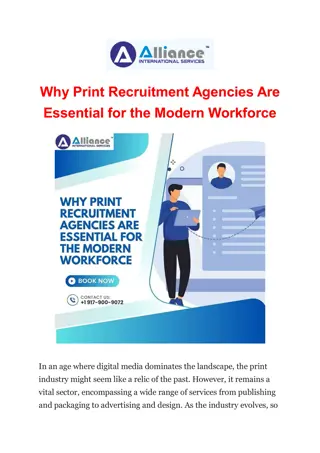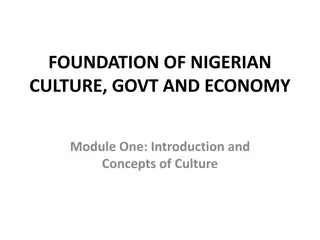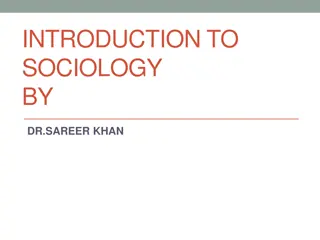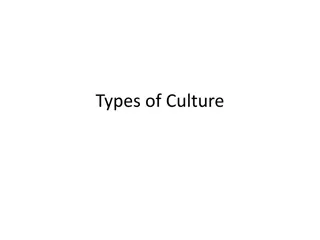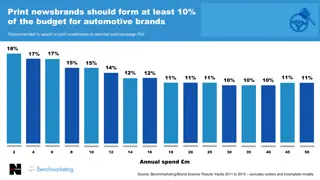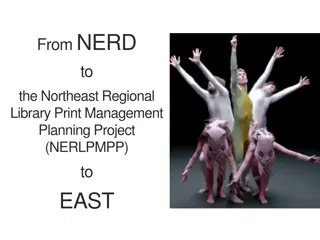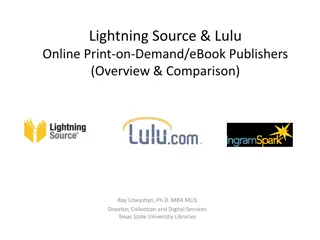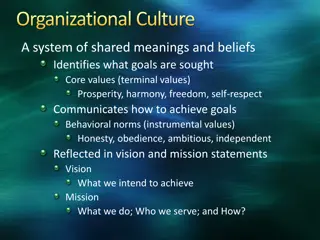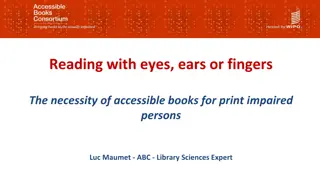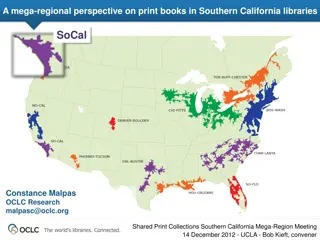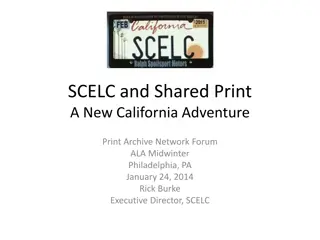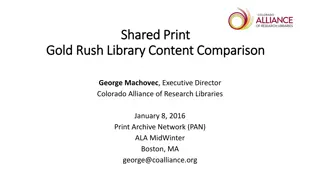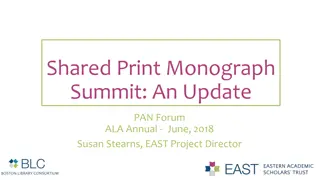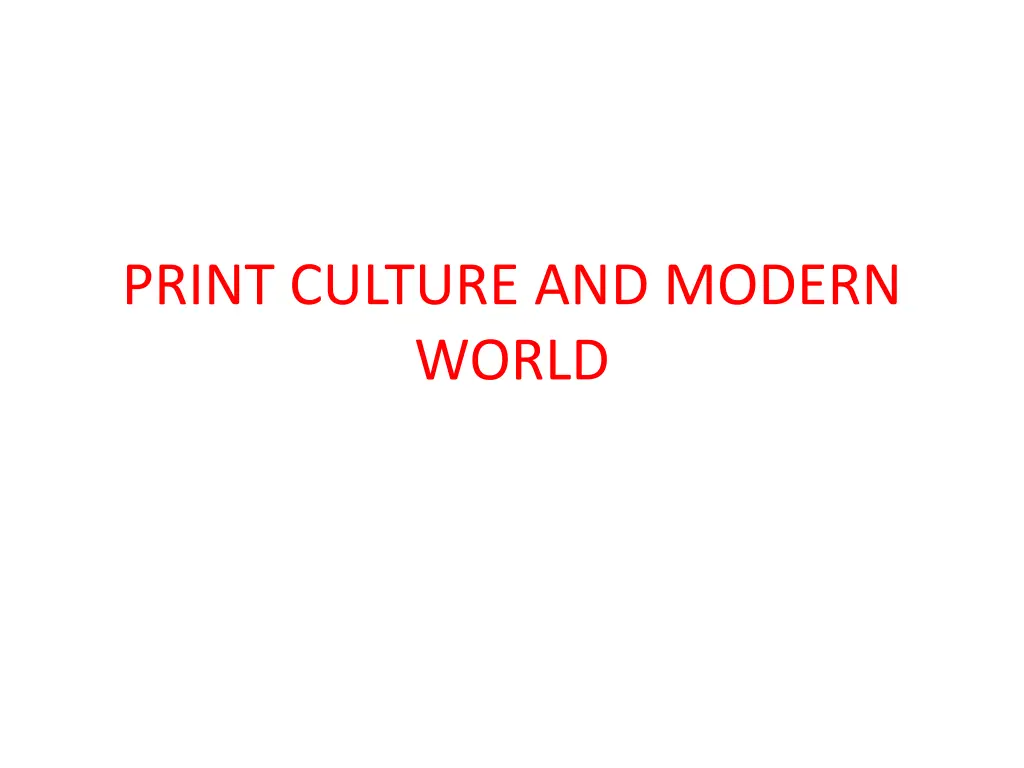
Exploring Print Culture in Modern World
Dive into the evolution of print culture from its origins in East Asia to its global impact on social lives and cultures. Discover the technological advancements, historical context, and societal changes influenced by the introduction of printing.
Download Presentation

Please find below an Image/Link to download the presentation.
The content on the website is provided AS IS for your information and personal use only. It may not be sold, licensed, or shared on other websites without obtaining consent from the author. If you encounter any issues during the download, it is possible that the publisher has removed the file from their server.
You are allowed to download the files provided on this website for personal or commercial use, subject to the condition that they are used lawfully. All files are the property of their respective owners.
The content on the website is provided AS IS for your information and personal use only. It may not be sold, licensed, or shared on other websites without obtaining consent from the author.
E N D
Presentation Transcript
PRINT CULTURE AND MODERN WORLD
INTRODUCTION... In this chapter we will look at the development of print, from its beginnings in East Asia to its expansion in Europe and in India. We will understand the impact of the spread of technology and consider how social lives and cultures changed with the coming of print.
MAKING OF BOOK BEFORE INTRODUCTION OF PRINT
THE FIRST PRINTED BOOKS The earliest kind of print technology developed in China, Japan and Korea, called hand printing. From AD 576 onwards, books in China were printed by rubbing paper against inked surface of woodblocks.
ACCORDION BOOK The traditional Chinese accordion book was folded and stitched at theside.
CALLIGRAPHY Calligraphy stylized writing. is the art of beautiful and Superbly skilled craftsmen could duplicate it with accuracy.
For a very long time China remained the major producer of printed material. Further the civil service examinations expanded the use of print material. Apart started using print material. from scholars even merchants
Rich women began to read and publish their poetry and plays. New reading culture was accompanied by new technology of Western printing techniques and mechanical press. Shanghai became the hub of the new print culture.
PRINT INJAPAN Buddhist missionaries from china introduced hand-printing technology into Japan (AD 768- 770). The oldest Japanese book, printed in AD868,is the Buddhist DIAMOND SUTRA .
Pictures were printed on textiles, playing cards and paper money. In medieval Japan, poets and prose writer were regularly published. Books were cheap abundant. Printing interesting publishing practices. of visual material led to
PRINT COMES TOEUROPE In returned exploration in China. 1295, Marco Italy polo, after a great many explorer years to of He brought the knowledge of print technology back with him from China. Luxury editions were still hand written on very expensive VELLUM.
Demand for books increased and Europe began exporting books countries. to different Book fairs were held. Scribes started working for booksellers.
LIMITATIONS Handwritten manuscripts could increasing demand for book. not satisfy the ever- Copying was expensive, laborious and time consuming. Manuscripts were fragile, difficult to handle and carry around. Their circulation remained limited. Thus there was a great need for quicker and cheaper production.
RISE OF PRINTINGPRESS Johann Gutenberg was merchant and agricultural estate. the son of a on a grew up large He became a master goldsmith. He trinkets. created lead moulds for making He adopted this technology to design new innovations.
The olive press provided the model for printing press. Moulds were used for casting metal types for the letters. By 1448, he perfected the system. The first book he printed was THE BIBLE with 180 copies. It took 3 yrs to produce them.
By the standards of time the production became fast. But this new technology did not entirely displaced the art of producing books by hand. The mechanical Revolution . shift hand led printing the to from printing to Print
PRINTREVOLUTION (MEANING) Development of new ways of producing books Transformed the lives of people. Change in their relationship with institutions and authorities. Influenced popular perceptions. Opened up new ways of looking at things.
IMPACT OFPRINT REVOLUTION A NEW READING PUBLIC A. RELIGIOUS DEBATES AND FEAR OF PRINT B. PRINT ANDDISSENT C.
B. RELIGIOUS DEBATES AND THE FEAR OFPRINT Print ideas. created the wide circulation of Introduced discussion. anew world of debateand
FEAR OFPRINT.... Many were apprehensive of the effect of wider circulation of books on the mind of the people. Rebellious spread. & irreligious thoughts might The authority of valuable literature would be destroyed. This anxiety to the widespread criticism of print media.
C. PRINT ANDDISSENT Print & religious literature stimulated many distinctive individual interpretations of faith. Manocchio reinterpreted the message of bible and formulated a view of god & creation that enraged the Roman Catholic Church. Manocchio was executed for his heretical ideas.
The Roman Church was troubled by such effects of popular readings. Thus they imposed severe controls over publishers & booksellers. The Index of Prohibited Books was introduced from 1558.
THE READING MANIA The literacy levels in Europe increased up to 60 to 80 percent in 17th and 18thcentury. High literacy level created new reading public. Booksellers employed peddlers to roam and sell books.
PRINT CULTURE ANDTHE FRENCH REVOLUTION Many historians believe print culture created conditions which led to French revolution. Such as: A. Print popularized the ideas of enlightenment thinkers which included critical commentary on tradition, superstitions and despotism. Voltaire and Rousseau were among the prominent Enlightenment thinkers.
B. Print created a new culture of dialogue and debate. General public began to discuss the values, norms and institutions and tried to re- evaluate the established notions.
C. By the 1780s, there was a surge in literature which mocked the royalty and criticized their morality. Print helped in creating an image of the royalty that they indulged in their own pleasure at the expense of the common public.
The Nineteenth Century The 19th century saw vast leaps in mass literacy in Europe. This brought a large numbers of new readers among children, women and workers. Many keeping in mind the sense and sensibilities of children. books were written and printed
Many folk tales were rephrased to suit the children. Many women became important as readers as well as writers. The lending libraries which had been in existence from the 17thcentury became the hub of activity for white-collar workers, artisans and lower middle class people
FurtherInnovations Richard M. Hoe of New York perfected the power-driven cylindrical press by the mid 19thcentury. This could print 8,000 sheets per hour. Offset press was developed in the late nineteenth century. This could print up to six colors at a time.
Electrically operated presses came in use from the turn of the 20thcentury. This helped in accelerating the printing process. Many other innovations took place duringthis period. All the innovations had a cumulative effect which improved the appearance of printed texts.
New Strategies to sell books Many periodicals serialized important novels in the 19thcentury. In the 1920s in England, popular works were sold in cheap series, called the Shilling Series. The dust cover or book jacket is a 20th century innovation. Cheap paperback editions were brought to counter the effect of the Great Depression in the 1930s
India and the World of Print The printing press to Goa in the mid-16th century. Portuguese missionaries first brought The first books were printed in Konkani language. By 1674, about 50 books had been printed in Konkani and Kanara Languages. Catholic priests printed Malayalam book in 1579 respectively. the first Tamil and at Cochin and 1713
From 1780, James Augustus Hickey began to edit the Bengal Gazette. It was first weekly Indian newspaper brought out by Gangadhar Bhattacharya. Hickey also published a lot of gossip about the senior officials of the Company. Governor General persecuted Hickey. Warren Hastings
Warren publication newspapers colonial government. Hastings of to protect the encouraged officially the sanctioned image of the
Print culture helped in initiating new debate on religious, social and political issues in India. Many existing religious practices were criticized. Rammohun Roy published Sambad Kaumudi from 1821 to criticize the orthodox views in the Hinduism.
The Hindu orthodoxy commissioned the Samachar Chandrika to counter his opinions. In 1822, publication newspapers began, viz. Jam i- Jahan Nama and ShamsulAkhbar. Bombay Samachar; a Gujarati newspaper appeared in the same year. of two Persian
In north India, the ulama began to publish cheap lithographic prints which contained Persian and Urdu translations of holy scriptures. They also published religious newspapers and tracts. The Deoband Seminary was founded in 1867. It published thousands upon thousands fatwas about proper conduct in the life of Muslims.
Ramcharitmanas of Tulsidas was printed from Calcutta in 1810. From the 1880s, the Naval Kishore Press at Lucknow and the Shri Venkateshwar Press in Bombay published many religious texts in vernaculars.
Print helped in bringing the religious texts within reach of the common masses. It also helped in shaping the new political debate. It also helped in connecting the people from various parts of India; by carrying news of one part to another.
New Forms of Publication Initially, people got to read the novels which were written by European writers. But people could not relate to those novels because they were written in the European context. Many writers emerged who began to write in the Indian context.
People could correlate with the theme and characters of such novels in a better way. Many other new forms of writing also came into origin; like lyrics, short stories, essays about social and political matters, etc.
A new visual culture was taking shape by the end of the nineteenth century. Many printing presses started to produce visual images in large numbers. Works of painters; like Raja Ravi Varma were produced for mass circulation through printing.
Women and Print Many writers wrote about the lives and feelings of women. Due to this, readership among middle-class women increased substantially. There were many liberal husbands and fathers who stressed on women s education.
While some women got education at home, some others went to schools as well. This was the time, when many women writers also began to express their views through their writings.
While Urdu, Tamil, Bengali and Marathi print culture had developed early, Hindi printing began seriously only from the 1870s.
Print and the PoorPeople Very cheap small books were brought to markets in nineteenth century Madras towns. These books were sold at crossroads so that poor people could buy them. Public libraries were set up from the early twentieth century which helped in increasing the access to books. Many rich people set up library in order to assert their prestige in theirarea.
Print and Censorship Before 1798, the colonial rulers were not too concerned with censorship. Initially, the control measures were directed against Englishmen in India who were critical of Company misrule.
After the revolt of 1857, the attitude to freedom of the press changed. The Vernacular Press Act was passedin 1878. The Act provided the governmentwith extensive rights to censor reports and editorials in the vernacular press.
In case of a seditious report, the newspaper was warned. If the warning was ignored, the press was liable to be seized and the printing machinery confiscated.


